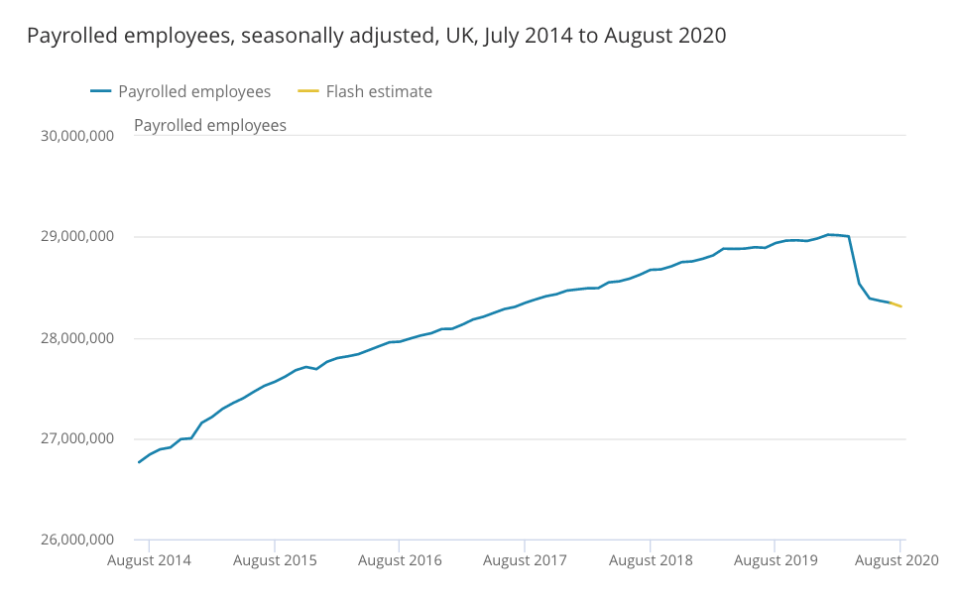UK employers have cut 695,000 jobs since March as unemployment rate rises

UK employers have slashed 695,000 jobs since March when the coronavirus first sent Britain into national lockdown.
Britain’s official unemployment rate also increased as expected by analysts to 4.1% between May and July, from 3.9% a month earlier, according to new data from the Office for National Statistics (ONS) published on Tuesday.
The claimant count, which includes unemployed and low-paid workers receiving work-related benefits, stood at 2.7 million last month, up 120.8% since March.
New estimates also show the total number of jobs in Britain has fallen by 354,000 to 35.4 million between March and June, the steepest fall in almost three decades.
Watch: Unemployment rate climbs as pandemic takes toll
Chancellor Rishi Sunak said it was a “difficult time for many,” but said protecting jobs and supporting people back into work was his “number one priority.”
READ MORE: UK firms warn on ‘triple threat’: Local lockdowns, furlough wind-up, and Brexit disruption
But vacancies have begun to rise more recently, reaching 434,000 between June and August.
Unemployment statistics have become increasingly controversial in recent months, however. A constant flurry of high-profile job losses have not been fully borne out in the government’s official figures. The employment rate even increased to 76.5%.
Watch: Why have job losses risen despite the economy reopening? Yahoo Finance UK’s reporter, Tom Belger, explains
The figures’ definition follows International Labour Organisation rules, but critics highlight a large timelag in the data, the need to be actively job-hunting to count as unemployed, and the labelling of furloughed workers as employed.
Michael Hewson, chief market analyst at CMC Markets UK, called the official rate “not fit for purpose” in a note last week. “We’ve already seen swathes of job losses announced over the summer from airlines, aerospace and the retail sectors which will eventually start to show up in the headline numbers.”
READ MORE: UK faces 450,000 job cuts and soaring foodbank use by Christmas
It comes amid a clamour of warnings that unemployment will continue to rise later this year, and pressure for new government support for employers as the furlough scheme is wound down. More than five million workers were classed as “temporarily away” from work in July by the ONS, including many on subsidised furlough leave, while an estimated 250,000 workers had jobs “on hold,” receiving no pay at all.
New analysis by the National Institute of Economic and Social Research (NIESR) on Monday predicted that unemployment could hit 9.8% in the final three months of the year.

Another think tank, the Institute of Employment Studies, predicted around 450,000 workers would have lost their jobs by the end of the autumn, after analysing official data on redundancies.
Meanwhile Trades Union Congress (TUC) general secretary Frances O’Grady told the union body’s annual conference on Monday Britain faced a “tsunami” of job cuts as support for employers was wound down by chancellor Rishi Sunak.
Ruby McGregor Smith, president of the British Chambers of Commerce (BCC), also announced on Tuesday she had written to prime minister Boris Johnson on Tuesday warning of a “difficult winter ahead.”
READ MORE: Millions of UK households face £1,000 cliff edge next year
“If the government wishes to avoid mass unemployment, significant levels of business failure, and long-term economic scarring in our communities, we urge you and your colleagues to act now,” she wrote.
The BCC echoed the IES’ call for the government to slash the cost of keeping staff for employers by raising the thresholds for their national insurance contributions.
Sunak said in a statement: “We’ve taken decisive action throughout this crisis, introducing the furlough scheme and outlining a comprehensive Plan for Jobs to support, protect and create opportunities.
“And we’ll continue to do that through the autumn, including by supporting people back to work through policies such as our Job Retention Bonus worth up to £9bn.”

 Yahoo Finance
Yahoo Finance 